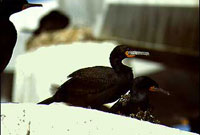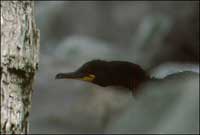Mystery Cormorant
This bird appeared briefly at the Ocean Shores jetty and was photographed by Dennis Paulson, who risked life and limb oozing over the rocks toward it for a series of relatively close shots. It then flew out into the water, where it was photographed several more times.
It is clearly not one of the expected species of the region, Double-crested, Brandt's, or Pelagic. It is not any species known from the North Pacific. In fact, it matches no known cormorant in the world.
Michael Price sent in the suggestion that this bird was a Cape Cormorant (Phalacrocorax capensis), from the Benguela Current of South Africa, and it does indeed look like photos of that species in some books. Serendipitously, I am heading for South Africa as I write this, and I will be looking hard at and photographing Cape Cormorants to see if there is indeed a match. Stay tuned.
Douglas Causey suggested the bird might be a subadult Neotropic Cormorant (Phalacrocorax brasilianus), and that's another reasonable guess (and is the nearest species not yet recorded from Washington), but the configuration of the throat pouch seems not quite right, and I have always thought that as soon as a Neotropic Cormorant becomes black (in its second year), it should have white feathering along the rear edge of the throat pouch. Also, Neotropic doesn't normally have such a vivid contrast between black bill and yellow throat pouch. I've seen hordes of them, and I haven't seen any that look like this.
Bengt Karlsson in 2003 suggested the bird is a European Shag (Phalacrocorax aristotelis), and indeed it has much in common with that species, especially the bright and contrasty yellow throat pouch and black bill. From photos I've checked, the shag looks shorter-tailed than the mystery bird, and the configuration of yellow on the throat looks different, the shag having a smaller area of yellow than this bird, especially obvious from below.
As always, I am hampered by lack of knowledge of the variation within each of these similar species. I feel no closer to a solution than I was in 1980 when I took the photos!
Additional comments about these photos will always be appreciated by Dennis Paulson
- Mystery cormorant, Ocean Shores, WA, 12 Jul 1980
- Mystery cormorant, Ocean Shores, WA, 12 Jul 1980
- Mystery cormorant, Ocean Shores, WA, 12 Jul 1980
- Mystery cormorant, Ocean Shores, WA, 12 Jul 1980
- Mystery cormorant, Ocean Shores, WA, 12 Jul 1980
Here is another photo, of actual Cape Cormorants taken in South Africa. The photo was scanned at two different scales and modified slightly from the original (the birds were not modified!). These birds were photographed at a breeding colony, and they differ from the Ocean Shores bird in having more brightly colored throat pouches, but the configurations of the colors are as much like those of the Ocean Shores bird as any cormorant. However, note that the colored skin of the throat pouch comes up farther onto the face (equal to the top of the bill) in the Cape Cormorants than it does in the mystery bird. Also, the mystery bird seem to have a longer tail than is typical of a Cape Cormorant, but I'm not sure of that, from the one photo showing its tail. I'm not yet not ready to assign a name to this bird other than Phalacrocorax mysteriosus.
- Cape Cormorant, Lambert's Bay, South Africa, 6 Nov 1997
- Cape Cormorant, Lambert's Bay, South Africa, 6 Nov 1997
Here is a comparison of two of the photos.
Alcids
- Female Long-billed Murrelet, 12 mi W Pomeroy, Garfield Co., WA, 14 Aug 2001, specimen in Connor Museum, Washington State University

